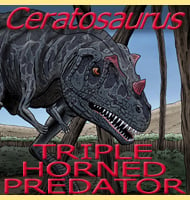In Depth
Tropeognathus was first named in 1987 after the description of a pterosaur skull that had been purchased from a fossil dealer. In 2002 a set of lower jaws was further attributed to the genus, and most recently at the time of writing a third specimen was added in 2013, and this was the first inclusion of post cranial remains. Today these specimens all represent members of the type species Tropeognathus mesembrinus which is held as valid, while a second species, Tropeognathus robustus which was also named in 1987 and based upon a more robust jaw, has a questionable validity.
Only two years after Tropeognathus was established, there was speculation that it might have actually been a specimen of Anhanguera (Kellner, 1989). Tropeognathus has also been considered a synonym to Coloborhynchus (Veldmeijer, 1998), Criorhynchus (Fastnacht, 2001) and Ornithocheirus (Unwin, 2001). With the addition of new post cranial remains in 2013 however, Tropeognathus has now gained a wider acceptance to its validity, and a 2013 taxonomic review by Rodrigues and Kellner supported the view that Tropeognathus is a valid genus.
Tropeognathus is easily amongst the largest known ornithocheirid pterosaurs, a kind that seem to have been best adapted for flying over bodies of water and snatching fish from the water. Also with the addition of new fossil material in 2013, Tropeognathus was the largest pterosaur from Gondwana, the amalgamation of the southern continents that were largely separated from the northern continents that are known as Laurasia. Only the largest azhdarchid pteroasurs such as Quetzalcoatlus from North America are known to have comfortably exceeded Tropeognathus in size. Like relative genera, Tropeognathus had a toothed beak, and large rounded growths which have been dubbed ‘keels’ rising from the tips of both upper and lower jaws.
The wings of Tropeognathus seem to be very long while at the same time thin, similar to some other types of pterosaurs such as pteranodonts. This may indicate that large ornithocheirds like Tropeognathus may have used a flight principal called dynamic soaring to conserve energy. This is where air current passing over ocean waves are exploited so that an individual can use them to pick up speed and lift without having to expend energy to continuously flap the wings. This idea of flight has also been proposed for the pterosaur Pteranodon, and can be seen in action by some modern sea birds such as the albatross which although has a different wing construction, has a roughly similar wing proportion. Glider pilots are also known to use this flight principal, though usually more often on a grander scale such as an air current rising over a mountain.
Further Reading
- New crested pterosaurs from the Lower Cretaceous of Brazil. - Mitteilungen der Bayerischen Staatssammlung f�r Pal�ontologie und historische Geologie 27: 175–186; Muenchen - Peter Wellnhofer - 1987. - An overview of the pterosaur assemblage from the Cambridge Greensand (Cretaceous) of Eastern England. - Mitteilungen aus dem Museum f�r Naturkunde in Berlin, Geowissenschaftliche Reihe 4: 189–221. - D. M. Unwin - 2001. - First record of Coloborhynchus (Pterosauria) from the Santana Formation (Lower Cretaceous) of the Chapada do Araripe of Brazil. - Pal�ontologisches Zeitschrift, 75: 23–36. - M. Fastnacht - 2001. - Pterosaurs from the Lower Cretaceous of Brazil in the Stuttgart collection, - Stuttgarter Beitr�ge zur Naturkunde Serie B (Geologie und Pal�ontologie) 327: 1–27. - A. J. Veldmeijer - 2002. - The largest flying reptile from Gondwana: A new specimen of Tropeognathus cf. T. mesembrinus Wellnhofer, 1987 (Pterodactyloidea, Anhangueridae) and other large pterosaurs from the Romualdo Formation, Lower Cretaceous, Brazil. Anais da Academia Brasileira de Ci�ncias 85: 113. - A. W. A. Kellner, D. A. Campos, J. M. Say�o, A. N. A. F. Saraiva, T. Rodrigues, G. Oliveira, L. A. Cruz, F. R. Costa, H. P. Silva & J. S. Ferreira - 2013. - Taxonomic review of the Ornithocheirus complex (Pterosauria) from the Cretaceous of England. - ZooKeys 308: 1. - Taissa Rodrigues & Alexander Kellner - 2013.










